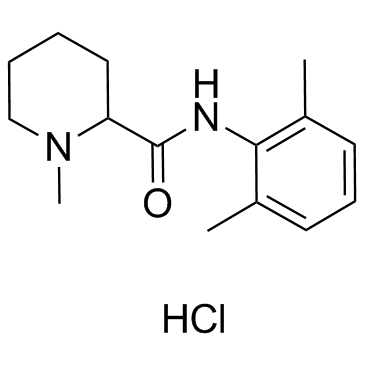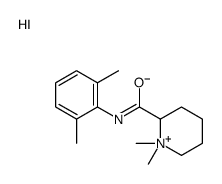Mepivacaine hydrochloride
Modify Date: 2024-01-01 20:02:59

Mepivacaine hydrochloride structure
|
Common Name | Mepivacaine hydrochloride | ||
|---|---|---|---|---|
| CAS Number | 1722-62-9 | Molecular Weight | 282.809 | |
| Density | N/A | Boiling Point | 383.1ºC at 760 mmHg | |
| Molecular Formula | C15H23ClN2O | Melting Point | 255-257ºC (dec.) | |
| MSDS | Chinese USA | Flash Point | 185.5ºC | |
| Symbol |

GHS06 |
Signal Word | Danger | |
Use of Mepivacaine hydrochlorideMepivacaine is a tertiary amine used as a local anesthetic.Target: Sodium ChannelMepivacaine is a local anesthetic of the amide type. Mepivacaine has a reasonably rapid onset (more rapid than that of procaine) and medium duration of action (shorter than that of procaine). Mepivacaine is used in any infiltration and regional anesthesia. It is supplied as the hydrochloride salt of the racemate [1]. Mepivacaine displayed a preferential use-dependent block of Na(v)1.8, S(-)-bupivacaine displayed a preference for TTXs Na(+) channels [2]. |
| Name | mepivacaine hydrochloride |
|---|---|
| Synonym | More Synonyms |
| Description | Mepivacaine is a tertiary amine used as a local anesthetic.Target: Sodium ChannelMepivacaine is a local anesthetic of the amide type. Mepivacaine has a reasonably rapid onset (more rapid than that of procaine) and medium duration of action (shorter than that of procaine). Mepivacaine is used in any infiltration and regional anesthesia. It is supplied as the hydrochloride salt of the racemate [1]. Mepivacaine displayed a preferential use-dependent block of Na(v)1.8, S(-)-bupivacaine displayed a preference for TTXs Na(+) channels [2]. |
|---|---|
| Related Catalog | |
| References |
| Boiling Point | 383.1ºC at 760 mmHg |
|---|---|
| Melting Point | 255-257ºC (dec.) |
| Molecular Formula | C15H23ClN2O |
| Molecular Weight | 282.809 |
| Flash Point | 185.5ºC |
| Exact Mass | 282.149902 |
| PSA | 32.34000 |
| LogP | 3.53910 |
| Vapour Pressure | 4.52E-06mmHg at 25°C |
CHEMICAL IDENTIFICATION
HEALTH HAZARD DATAACUTE TOXICITY DATA
|
| Symbol |

GHS06 |
|---|---|
| Signal Word | Danger |
| Hazard Statements | H301 |
| Precautionary Statements | P301 + P310 |
| Personal Protective Equipment | dust mask type N95 (US);Eyeshields;Faceshields;Gloves |
| Hazard Codes | Xn: Harmful; |
| Risk Phrases | R22 |
| Safety Phrases | S22-S24/25 |
| RIDADR | UN 2811 6.1 / PGIII |
| RTECS | TK6475000 |
| HS Code | 2933399090 |
| Precursor 0 | |
|---|---|
| DownStream 1 | |
| HS Code | 2933399090 |
|---|---|
| Summary | 2933399090. other compounds containing an unfused pyridine ring (whether or not hydrogenated) in the structure. VAT:17.0%. Tax rebate rate:13.0%. . MFN tariff:6.5%. General tariff:20.0% |
|
Estimation of skin concentrations of topically applied lidocaine at each depth profile.
Int. J. Pharm. 475(1-2) , 292-7, (2014) Skin concentrations of topically administered compounds need to be considered in order to evaluate their efficacies and toxicities. This study investigated the relationship between the skin permeation... |
|
|
Use of magnesium in moderating tachycardia in acute severe asthma in pregnancy.
Br. J. Anaesth. 110(6) , 1059, (2013)
|
|
|
First report of hepatectomy without endotracheal general anesthesia.
J. Am. Coll. Surg. 216(5) , 908-14, (2013) Local anesthesia, including epidural anesthesia, has much merit over general anesthesia for the reduction of perioperative cardiac and respiratory complications. Liver operations commonly require gene... |
| (±)-1-Methyl-2',6'-pipecoloxylidide monohydrochloride |
| Mepivacaine hydrochloride |
| Mepivastesin |
| N-(2,6-dimethylphenyl)-1-methylpiperidine-2-carboxamide,hydrochloride |
| (±)-N-(2,6-Dimethylphenyl)-1-methylpiperidine-2-carboxamide Hydrochloride |
| Scandicain |
| 1-Methyl-2',6'-pipecoloxylidide hydrochloride |
| Carbocaina |
| N-(2,6-diméthylphényl)-1-méthylpipéridine-2-carboxamide chlorhydrate |
| 1-Methyl-2',6'-pipecoloxylidide monohydrochloride |
| N-(2,6-Dimethylphenyl)-1-methyl-2-piperidinecarboxamide Hydrochloride |
| Mepivicaine hydrochloride |
| N-(2,6-dimethylphenyl)-1-methylpiperidine-2-carboxamide hydrochloride |
| Mepivacaine HCL |
| N-(2,6-Dimethylphenyl)-1-methylpiperidin-2-carboxamidhydrochlorid |
| N-(2,6-Dimethylphenyl)-1-methylpiperidine-2-carboxamide hydrochloride (1:1) |
| N-(2,6-Dimethylphenyl)-1-methyl-2-piperidinecarboxamide hydrochloride (1:1) |
| MFCD00243006 |
| Carbocaine hydrochloride |
| Meaverin |
| 2-Piperidinecarboxamide, N-(2,6-dimethylphenyl)-1-methyl-, hydrochloride (1:1) |
| EINECS 217-023-9 |
| Mepivacaine (hydrochloride) |
 CAS#:345261-08-7
CAS#:345261-08-7
